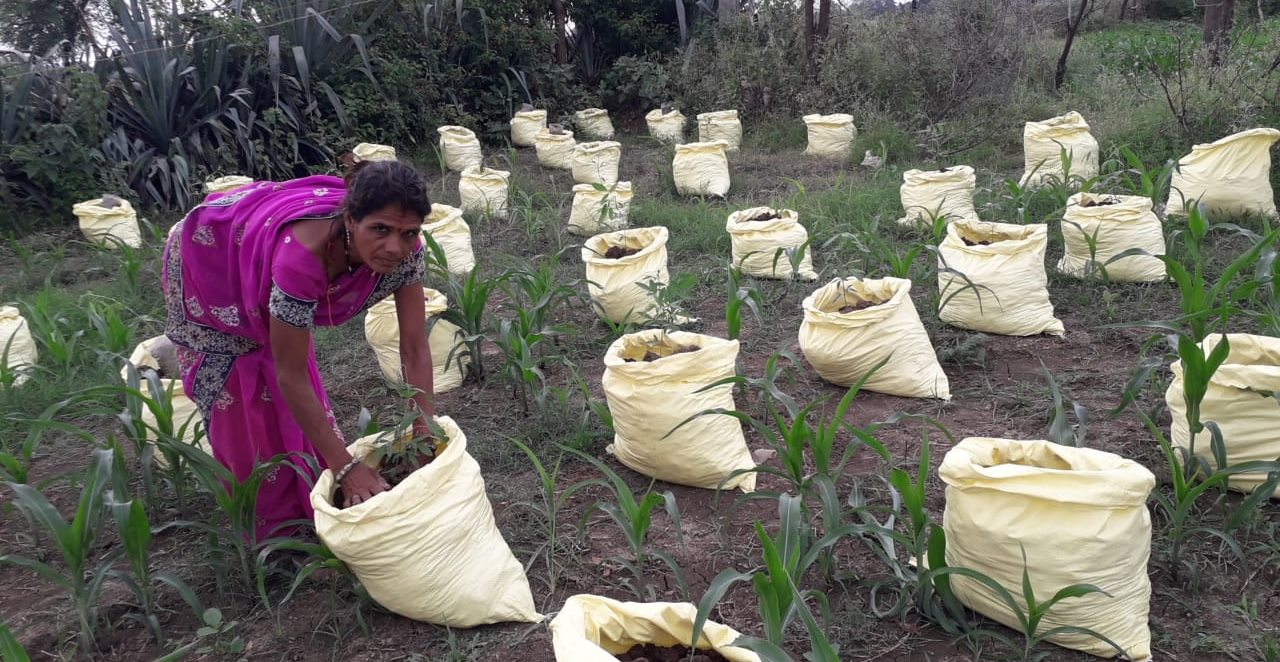Jawahar Model of farming with bags of merit
Scientists at the Jawaharlal Nehru Agricultural University, Jabalpur in Madhya Pradesh have developed the Jawahar Model of farming in which crops are grown not on land but in grow-bags. This technique is less expensive, uses less water and fertilisers, and needs limited space.


Growing crops in grow-bags saves the farmer a lot of expenditure, say scientists. All photos: By arrangement
Jyoti Patel surveyed her crop of arhar dal (pigeon pea pulse) and vegetables, and nodded in satisfaction. “It has been a bumper crop this time,” the 40-year-old farmer from Panagar in Jabalpur district, Madhya Pradesh, told Gaon Connection. Jyoti Patel and many other farmers are experimenting with the Jawahar Model of farming, developed by scientists of the Jawaharlal Nehru Agricultural University in Jabalpur.
Jawahar Model recommends growing the crops, not on land, but in grow-bags or sacks. And the yield is good too.
“A group of us went to the agriculture university where we learnt of the Jawahar Model. We do not have such big lands where we can use tractors, etc., and this model seemed perfectly suited for us,” Jyoti said. She added that they were also told about how to go about growing produce in grow-bags even in limited space in and around their homes.
“I have sowed arhar in 200 sacks and the yield is much more than what I would have got had I grown them on the ground,” the farmer said.

Also Read: Banana stems become the unlikely protectors for the fiery bhut jolokia chilli
“Six hundred and fifteen women farmers, like Jyoti Patel, who are part of self help groups have adopted the Jawaharlal Model of cultivation,” DP Tiwari, district manager, National Rural Livelihood Mission (NRLM) Jabalpur, told Gaon Connection. “Most of them are growing vegetables and arhar in grow bags in and around their homes,” he added.
Savings for the farmers
According to the scientists who developed the Jawahar Model, growing crops in grow-bags saves the farmer a lot of expenditure. And, even those who have barren lands can make use of the space to grow produce and earn a livelihood. Even terraces of homes can be put to good use, they said.

“The biggest expense for farmers is incurred during ploughing, sowing and in buying fertilisers and pesticides. And in India a huge percentage of farmers own less than an acre of land,” Moni Thomas, chief scientist, Jawaharlal Nehru Agricultural University, also known as Jawaharlal Nehru Krishi Vishwa Vidyalaya, told Gaon Connection.
“We have been conducting research for years on ways to improve the income of farmers. And this model is conducive to co-cropping and suitable even for the farmers who have very small holdings,” the scientist pointed out.
Also Read: A zero tillage seed drill assures farmers of better yield and more savings

How to grow crops in grow-bags
Each sack/grow-bag is filled with a mixture of soil and cow dung manure. “While farmers may need fifteen to twenty kilograms of seeds for an acre of land, they need very little if they decide to grow their plants in a grow-bag,” Thomas informed.
Explaining the process, the scientist said: “One sapling is planted in each bag so that it can grow with ample space around it, and each sapling can give up to two and a half kilograms of arhar.” Further, an acre of land has enough space to accommodate 1,200 grow-bags, he elaborated.
Since each growbag has only one sapling of the arhar, the sack has enough space to grow coriander or turmeric, he added. “Nearly 500 grams of coriander can be harvested from each bag. And, if 50 grams of turmeric seeds are sown in a bag, it can give an yield of up to two and a half kilograms of turmeric in six months,” Thomas informed. Vegetables such as spinach, radish, brinjal, tomatoes, bottle gourd and chillies grow well in this model of farming, too.

Also Read: A new bioformulation, mixed with jaggery and cow dung, promises to tackle crop residue
“Growing coriander, ginger and turmeric along with the arhar, gives the women farmers additional produce that can be harvested before the arhar. This enables them to get an additional income,” Tiwari, the NRLM district manager, said.
Reduced expenditure on fertiliser and savings on water
Listing out the other advantages of this model of growing produce, Thomas said that bio fertilisers are added to the soil mixture before it is filled into the growbags. After which no additional fertiliser is required. “When fertilisers are put on the ground, a lot of it is dispersed in the soil. In a bag however, it remains available to the plant and continues to enrich the soil,” he explained.
There is a saving on water consumption too. In a field, the farmer has to irrigate the entire area. In these growbags, the farmer needs to just water that one plant and even if it is watered once a week, it is fine, Thomas said.

According to scientists at Jawaharlal Nehru Agricultural University, the grow-bags last for up to two years, and if they tear, all the farmer needs to do is to replace the bag and fill in the same soil.
According to Thomas, if the farmer so desired, she could even nurture lac insects in the arhar sapling. The lac would be an additional source of income and the insects do not damage the arhar plant. Each arhar sapling could yield 350 grams of lac in a period of eight months, he said.
Farmers from states other than Madhya Pradesh are also visiting the agricultural university in Jabalpur to find out more about the Jawahar Model. “It is our aim to help farmers augment their incomes. In the coming days when there will be less and less land to cultivate on, this model could be the farmers’ saviour,” Thomas concluded.
Read the story in Hindi.

